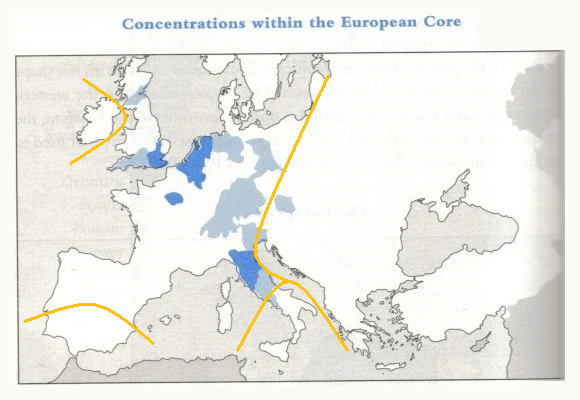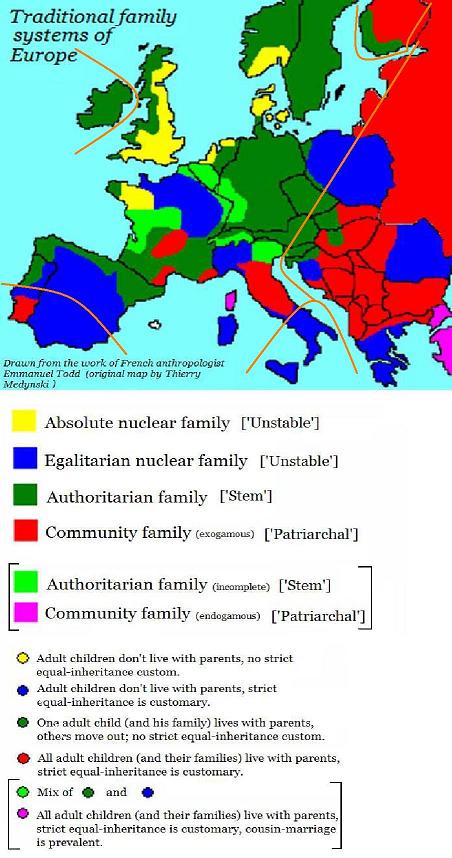The Medieval Economy of Fief and Church
( … )
In examining the origins of the monastic cloister, Walter Horn found that “as a manorial entity the Carolingian monastery … differed little from the fabric of a feudal estate, save that the corporate community of men for whose sustenance this organization was maintained consisted of monks who served God in chant and spent much of their time in reading and writing.
A monastery was a corporation, and served the same function as it does today.
The Hide System
Marital Genetic Pacification: De-Clannification
Interbreeding: Christian canon law followed Roman civil law, and forbade marriage within four degrees of consanguinity. This mandate persisted among Christians of the Middle East, with equally beneficial consequences compared to their Muslim neighbors.
|Breeding|: Inbreeding (Family, Consanguinity) > Nearbreeding(Kindred) > Interbreeding (Subrace) > outbreeding (Race)
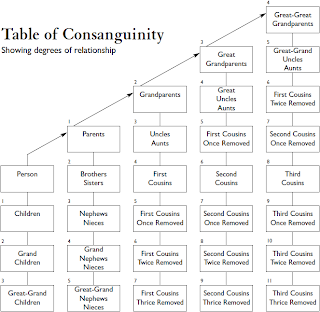 Rates of interbreeding. From high degrees of consanguinity (light) to low degrees of consanguinity (dark).
Rates of interbreeding. From high degrees of consanguinity (light) to low degrees of consanguinity (dark).
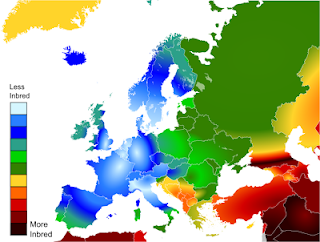
Economic Genetic Pacification: Bipartite Manorialism
Starting in about seven hundred, Nothern Europe developed manorialism. Manorialism, or ‘pico-states‘ originated in the Roman villa system of the Late Roman Empire. And manorialism was widely practiced in medieval western and parts of central Europe as well as China.
Just as the Aristocracy granted land (access to capital) and therefore possibility of income to those who would produce military service, Manorialism granted access to land (capital) in exchange for economic service.
Legal and economic decisions for the manor were made by the lord of the manor.
Feudalism required a hierarchy of legal and military relationships among nobles, and Manorialism extended this system to the legal and economic relationships between nobles and peasants. Each lord of the manor was supported by his own direct landholding in a manor (sometimes called a fief), and from the obligatory contributions of a legally subject part of the peasant population under his jurisdiction and that of his manorial court. These obligations could be payable in several ways, in labor (the French term corvée is conventionally applied), in kind or in coin.
|Agrarian Industrial Organization|: Manor (small and w/o mlitary obligation) > Feif (larger and with military obligation)
A Feif consisted of heritable property or rights granted by an overlord to a vassal who held it in fealty (or “in fee”) in return for a form of feudal allegiance and service, usually given by the personal ceremonies of homage and fealty. The fees were often lands or revenue-producing real property held in feudal land tenure: these are typically known as fiefs or fiefdoms. However, not only land but anything of value could be held in fee, including governmental office, rights of exploitation such as hunting or fishing, monopolies in trade, and tax farms.
A peasant referred to an agricultural laborer or farmer with limited land ownership, under feudalism and paying rent, tax, fees, or services to a landlord. Peasants hold title to land either in fee simple or by any of several forms of land tenure, among them socage, quit-rent, leasehold, and copyhold. The term was not a pejorative. Althought it evolved to be synonymous with ‘criminals’ in later centuries, and with ignorance in after the industrial revolution.
Three classes of peasants existed: slave, serf, and free tenant. A slave served by negative incentives (threats of harm or deprivation). They could not marry (and of course not be ordained) … A serf was debt bound, in indentured servitude and served at least in part by his self interest. A free tenant could get married without permission and they could not be moved between estates against their will. In practice, the difference between free tenants varied across the continent with the method of taxation a better indication of one’s status.
The Catholic Church, always in pursuit of customers over which they had influence, actively suppressed Slavery, promoted the transformation of slavery to serfdom and enslavement of Catholics was prohibited in 992 – but the legality of enslaving people of other religions and dogmas remained. It became increasingly uncommon through the Middle Ages, until effectively replaced by serfdom by the end of the 10th century.
Perhaps more important for our discussion here, is that free tenants had access to public courts – the common law. But serfs, like slaves, awere excluded from the public judicial system and judicial matters were attended to in the private courts of their respective lords.
The Economics of Domestication: Slaves are more productive and cheaper than brigands and enemies. Serfs are cheaper and more productive than slaves. Freemen are cheaper and more productive than serfs. And this distinctino continues up the scale of productivity. So while in the present we think of these conditions as oppression, they were in fact, defensive strategies for gradual domestication of human animals.
Or stated differently: European Aristocracy and Nobility profited from the incremental domestication of human animals. And as we shall see later on, only the Chinese came close – failing to develop law, and failing to end clannishness. The indians, facing overwhelming numbers, gave up, and practiced class segregation by caste instead on a scale european nobility could never achieve – especially by cloistering so many of their sons and daughters. The rest of the world failed entirely at eugenic evolution. Africa lacking time to develop sufficient order that it could -although european conquest of west africa probably interrupted their progress. And worst, the Muslim Revolution reversed eugenic evolution and destroying every civlization it came in contact with, destroying their arts, literature, traditions, governments, religions, and reducing each to endemic superstition, ignorance, poverty, trbalism, and dysgenia.
Manorialism delayed marriage and reproduction until a couple was of sufficient reliability and promise to obtain responsibility for the land. It provided an empirical test of one’s demonstrated behavior. It was a sort of equivalent to coming of age of maturity, or perhaps closer to citizenship. And a departure from serfdom and slavery. This manorialism spread horizontally across what is today protestant Europe and did not spread south into what is today’s Catholic Europe.
Nuclear Families: For instance, the distribution of nuclear families in europe. here’s a map of emmanuel todd’s traditional family systems in europe — the absolute, egalitarian, and stem families (yellow, blue, and green on the map) are all types of nuclear or small-sized families (the stem family is the immediate family plus one set of grandparents, so it has slightly more members than a pure nuclear family). as you can see, small families (nuclear and stem families) occur most frequently to the west of or “inside” the hajnal line, community or extended families more frequently outside of it.
The Consequence: The Hajnal Line of Eugenic Evolution
The Hajnal line is a border that links Saint Petersburg, Russia and Trieste, Italy. In 1965, John Hajnal discovered it divides Europe into two areas characterized by a different levels of nuptiality. To the west of the line, marriage rates and thus fertility were comparatively low and a significant minority of women married late or remained single; to the east of the line and in the Mediterranean and select pockets of Northwestern Europe, early marriage was the norm and high fertility was countered by high mortality.
“West of this line, the average age of marriage for women was 23 or more, men 26, spouses were relatively close in age, a substantial number of women married for the first time in their thirties and forties, and 10% to 20% of adults never married. East of the line, the mean age of both sexes at marriage was earlier, spousal age disparity was greater and marriage more nearly universal – in what has come to be known as the ‘Western European marriage pattern’.
While there are significant variations within the region; to the west of the line, about half of all women aged 15 to 50 years of age were married while the other half were widows or spinsters; to the east of the line, about seventy percent of women in that age bracket were married while the other thirty percent were widows or nuns.
“The region’s late marriage pattern has received considerable scholarly attention in part because it appears to be unique; it has not been found in any other part of the world prior to the Twentieth Century.
The demographic evidence from family reconstitution studies makes the prevalence of the pattern clear; while evidence is scanty, most English couples seemed to marry for the first time in their early twenties before the Black Death and afterward, when economic conditions were better, often married in their late teens.”
So, Hajnal discovered two significant influences common in western europe: late marriage and many individuals never marrying.
Judicial Genetic Pacification
State Monopoly on Violence: Throughout almost all of history, families and clans provided their own security, justice, and punishments. As a consequence feuds – clan and family warfare – were the norm. The state replaced clan violence and directed it toward its enemies.
Genetic Pacification: Beginning in the 11th century, Western Europe developed a growing consensus that the wicked should be punished so that the good may live in peace. Courts imposed the death penalty more and more often and, by the late Middle Ages, were condemning to death between 0.5 and 1.0% of all men of each generation, with perhaps just as many offenders dying at the scene of the crime or in prison while awaiting trial. Meanwhile, the homicide rate plummeted from the 14th century to the 20th, decreasing forty-fold.
Rapid Decline in Violence: from steven pinker’s Better Angels of the geography of homicide in late nineteenth-century Europe (hajnal line added by me). the homicide rates were significantly lower inside the hajnal line than outside of it in the late nineteenth century (more on this later in the post):
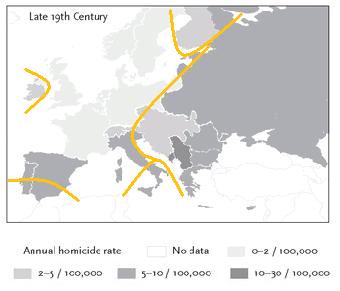
Downward Population Expansion of the Middle Classes:
( … )
The Unique Laboring, Working, and Lower Middle Classes: The most under-appreciated asset.
( … )
Civic Mindedness: (not collectiveness) the populations west of the hajnal line also appear to be more civic-minded than those to the east of it. civicness here is determined using robert putnam’s technique of looking at participation rates in voluntary associations. the data below are drawn from the world values survey — see more details in this post — and this one, too! (sorry, i haven’t got a map for these data, so you’ll have to make do with a table. the data for each individual country can be found in this post. the eastern european countries — circled in red — are all fully or partially east of the hajnal line. the remainder are not, although remember that southern italy and southern spain — two of the “southern europeans” here — are. note also that “anglos” includes the u.s., canada, australia, etc. — for great britain’s scores, see this post. click on table for LARGER view.)
Corporatization: The transformation of society from an army to a corporation
Intelligence: the distribution of average national IQs also are higher within the Hajnal line — in general, higher average national IQs are found inside the Hajnal line rather than outside of it
Corruption: perceived corruption is generally lower inside the Hajnal line than outside. here is a map based on transparency international’s corruptions perceptions index scores for Europe in 2012
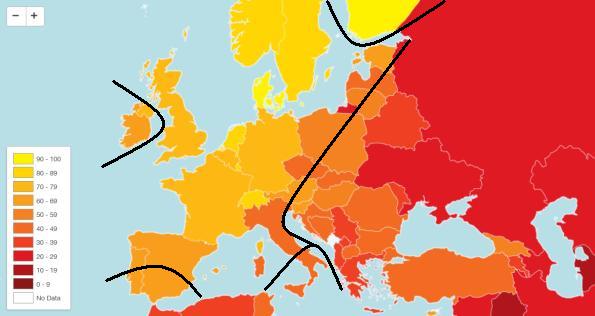 Exceptionalism: The shaded areas indicate the incidence of people whom Charles Murray terms “significant individuals,” who discovered or invented 98% of the artifacts and processes of modern civilization. They were all men, by the way. However, the map also includes the Hajnal lines, which demarcate the area of lower nuptiality centered in Europe (lower total fertility rates and higher minorities of women who marry later or remain single).
Exceptionalism: The shaded areas indicate the incidence of people whom Charles Murray terms “significant individuals,” who discovered or invented 98% of the artifacts and processes of modern civilization. They were all men, by the way. However, the map also includes the Hajnal lines, which demarcate the area of lower nuptiality centered in Europe (lower total fertility rates and higher minorities of women who marry later or remain single).
